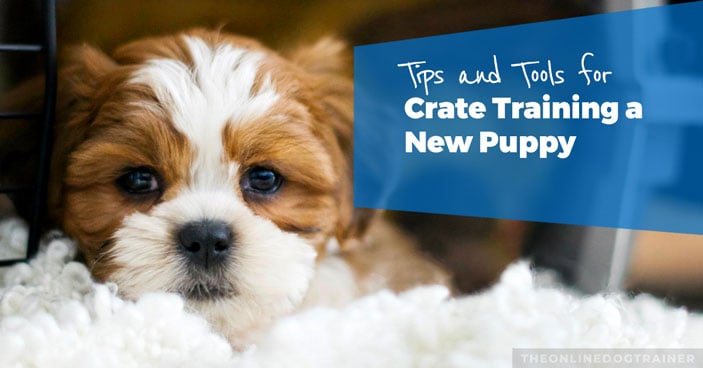Most dog trainers, veterinarians and breeders agree that crate training is generally beneficial for dogs and puppies. We’ll discuss the benefits of crate training in this post, along with some possible drawbacks.
My guess is by the time you’re done reading this post, you’ll likely choose to crate train your dog. I’ll be providing tons of help to do it correctly!
In this post, we’ll cover:
-
- Should Dogs Be Crate Trained?
- Free Professional Puppy Crate Training Tutorial
- Free Crate Training Printable Checklist
- What NOT to Do! Common Crate Training Mistakes
This post contains affiliate links. If you make a purchase, I’ll earn a commission (at no extra cost to you). As an Amazon Associate, I earn from qualifying purchases. I donate 10% of my earnings to animal charities.
Should Dogs Be Crate Trained?
There are many benefits to crate training your dog or puppy. It’s super important that crate training be done correctly, and we’ll discuss some crucial crate training steps later in this post. But some of the benefits of crate training include:
1. A crate provides a safe place for your dog. If it’s comfy with a dog bed and blanket, your dog will likely see it as a peaceful refuge, a place to rest, and a place to get away from activity going on in the house that may be to much for them.
2. Crate training can help with dog separation anxiety. For more information about this, read my post, Crate Training for Separation Anxiety (includes video). It’s important to learn what to do, and NOT do, when using a crate to help with separation anxiety.
3. A crate can help with potty training. Professional Dog Trainer, Doggy Dan, shows a new puppy owner how to use a crate to help potty train a puppy in this free puppy potty training video series.
Crate training is one of the most effective methods for house training. Since dogs will instinctively avoid going potty where they sleep, setting up a crate for your dog to sleep in will be a super effective tool for potty training.
Plus, the use of a crate helps puppy owners have more control over their puppy’s potty schedule, again, super helpful in the puppy potty training process!
4. A crate can protect your stuff! Puppies, young dogs, or dogs who suffer from anxiety will often destroy shoes and other household items, and chew on furniture when left unsupervised. Being in a crate will prevent destructive behavior and also prevent the dog from eating something harmful!
5. A crate can help with traveling. If your dog is crate trained, it’ll be easier to transport them. Plus, they’ll be able to take their “safe place” with them wherever they go! A crate can also be helpful for trips to the vet or in the case of an emergency evacuation. Check out these two posts for more information:
Tips for Traveling With Dogs (includes video)
Disaster Preparation for Your Pets (includes video)
Free Puppy Crate Training Tutorial
For step-by-step instructions on how to do crate training properly, visit Professional Dog Trainer, Doggy Dan’s free tutorial called, Crate Training Puppies.
Free Crate Training Checklist
To request a printable checklist of the 10 steps necessary to properly crate train your dog, click here.
What NOT to Do When Crate Training a Dog
Crate training can be detrimental to the health and safety of your dog, to your training efforts, and can also result in ongoing behavior issues for your dog if it’s not done correctly.
Watch my video below, then continue reading to learn about the most common crate training mistakes dog owners make.
Watch my video: 7 Things NOT to Do When Crate Training a Dog
7 Common Crate Training Mistakes
Some common mistakes dog owners make when crate training are:
1. Leaving the dog in the crate for too long.
2. Using the crate as punishment.
3. Forcing the dog to hold their bladder too long.
4. Confining the dog to the crate long after it’s necessary.
5. Not teaching the dog how to be comfortable with the crate.
6. Having a crate that’s too small.
7. Using the crate as a baby sitter.
For more details about these common crate training mistakes, read my post called, Crate Training Puppies (includes video!) which goes over these tips in more detail. In that post, we cover:
-
- Benefits of Crate Training Your Dog or Puppy
- Dangers and Precautions for Dog Crate Training
- Steps to Crate Train Properly
Also check out this post from the AKC (American Kennel Club) called, Crate Training Benefits: Why a Crate is Great for You and Your Dog.
I Donate to Animal Charities
Thank you for visiting my website! I hope this post has helped you decide whether crate training is right for you and your dog.
Crate training can certainly provide many benefits, to dogs and their owners. But like I said, it’s super important that you do it correctly.
You should know I receive a small commission for some of the products I recommend on this site. I donate 10% of my earnings the animal charities shown here.
If my site was helpful, please share it with your friends! Thanks so much. Debra











First of all, I think every pet owner should see this website and get knowledge on the cage usage. I believe a dog isnt just a dog but a family member. So would you lock your kids in a cage for long periods of time? But! I didnt know till i visited this site that dogs like to have personal space. Please read this awesome useful website! = ) thanks for getting the word out there!
Thank you so much, Mitchel!
This is great information! My sister works with dogs and the behavioural aspect of it. Lots of what you said in here I have heard from her too. Patience and praise I think are the most important. My dog loves her kennel. She can have the run of the house most of the time, but sometimes she needs to use the kennel. I give her a treat for going inside, she knows what to do before I even have the treat ready, she’ll run into the kennel and wait 🙂 She likes it. Good tips.
Thanks so much for sharing this – your dog sounds like a real sweetie!
We have successfully used crate training to house-break our dogs. It usually takes about 3 to 4 months.
We’re at the point now where we can confidently allow our dog the freedom of the entire house when we’re away (at work). When we return, everything is in its place. The dog does not GO in the house; he does not chew anything; he does not mess with anything other than his toys.
Crate training does work, but you have to be patient and persistent. And, you have begin training early, as a pup.
I agree patience and persistence is key!
Not sure about feeding in the crate..
Here’s an article directly from Professional Dog Trainer, Doggy Dan, about crate training that might help:
https://hop.clickbank.net/?affiliate=shermand22&vendor=doggyd4n&cbpage=crate-training
Thank you for visiting my website! Debra 🙂